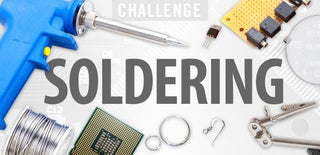Introduction: ESP8266 Weather Station With Arduino – #1 Hardware
Background
I read about the ESP8266 first in March this year and I didn't know what to do with. And now I'm really fascinated how easy the connection of an Arduino to the Internet can be. Like others I set up a weather station on a breadboard first and sent data to thingspeak.com. This ends up in a highly condensed stripboard layout and the needed software package.
Why stripboarding and not etching a PCB?
There are a lot of good PCB layouts around. But I want to build something that everybody can do easily at home. A soldering stick, stripboards and parts are easy to get. But etching a PCB is often a hurdle. So, my challenge was to make the design on a stripboard within the size and functionality of a etched PCB.
What are the functionalities?
- measure temperature, humidity, pressure and illuminance (brightness)!
- send all data to thingspeak
- ESP8266 can be turned on and off by Arduino for energy saving
- additional digital IOs
- Runs on 5 to 12 V
- and a lot more
Why ESP8266 and Arduino?
Every one of them have its advantages. The Arduino is perfect for dealing with sensors. And the ESP8266 is perfect for the Internet connection. And I can turn off the Internet for energy saving ;).
And the best:
The weather functionalities are only one aspect. You can measure nearly everything with this board because you have the following sensor pinouts of the Arduino:
- 2x analog
- 6x digital
- I2C for WIRE connections
- 1x reset
- 1x button
For a short impression:
The temperature and illuminance of the last three days somewhere in Germany: link
This is the hardware part of this project. The software is explained here: link
Step 1: Let's Build: Parts
To build this weather station you need some parts:
- 1x stripboard 20x15 vertical
- 1x ESP01
- 1x Arduino Mini Clone (this layout Arduino Mini, I chose the clone version because the position of A4 and A5 is more stripboard friendly compared to the official one)
- 1x DHT11 or DHT22
- 1x BMP180 shield (the one with 4 pins)
- 1x my temperature and illuminance sensor shield (link)
- Capacitors:
- 3x 100 µF (*)
- Z-diode
- 1x 3.3 V
- Resistor:
- 1x 10 kΩ
- 1x 360 Ω
- 1x 150 Ω (for red LED)
- AMS 1117
- 1x 3.3 V
- 1x 5 V (*)
- LEDs:
- 1x red
- 1x green
- or a bi-color one
- Headers:
- 1x 12x1 female
- 1x 6x1 female
- 2x 5x1 female
- 5x 4x1 female
- 1x 3x1 female
- 1x 2x1 female
- 3x 3x1 male (*)
- 1x 4x1 male
- 1x 4x1 male 90°
- 1x 3x1 male 90°
To (*): If you only want a 5V version you can reduce these parts by one.
Step 2: Cutting the PCB
First cut the stripes of the stripboard at the position shown in the drawing. To make this easier use the bottom view image. At the end count your cuts to be sure that you will not have wrong connections.
Step 3: Adding the Headers
Next step is soldering the headers to the board. Take care on the header in the lower right corner. You also have to solder the wire on the left side in the same hole.
Step 4: Wiring
Add all wires to the PCB. The colors are not important. They are only a orientation for me. On the top right corner there is a double usage of one hole. So you have to solder in the resistor in this step, too.
Step 5: Add Some Parts ...
Because the two AMS1117 are surface mounted parts you have to prepare them for through hole mounting. For this solder each to one 3x1 male header. After that you can easily place them together with all resistors, capacitors and the Z-diode on the PCB.
The LEDs are connected to the male header like seen in the image. The resistor is for the green leg.
Step 6: Full Setup With Labels
So, here you are. All parts are on the PCB. To check if everything works well and not to get short circuits or over voltages do the following tests first (use a multimeter):
- Measure the resistance between (1) and (3). Should be around 1 kΩ (not less!).
- Measure the resistance from (1) to all ground (GND, G) pins. Except (13)-G all should be 0 Ω.
- Connect a 9V battery to pin (1) (GND,-) and pin (3) (+).
- Measure 5 V voltages on pins (2), (8)-5, (9)-5, (10)-5, (12) and (14)-5.
- Measure 3.3 V voltages on pin (15).
If the board passed all five tests it's ready to put the components on.
Step 7: You Need Some Software
Yes, hardware is one part the software is the other. To explain and publish the software I will create an other instructable. Only few words to the concept:
The ESP8266 runs on Nodemcu and does the Internet connection. The Arduino does all the sensor related things. The communication between Arduino and ESP8266 is via serial connection whereby the Arduino uses the SoftwareSerial Library.
There's two modes in the Arduino software: standard and low power. The standard version powering the ESP01 once and sends data regularly (short periods) to thingspeak.com. The low power one sends the date also regularly but within longer periods. Between two sendings the ESP01 is powered down.
So, follow me for the further instructables.
If you want to write your own software here are the relevant pins for the Arduino:
- D2 Softserial TX
- D3 Softserial RX
- D4 DHT11 data
- D11 SW0
- D12 Connected to ESP8266 CH_PD: HIGH = On, LOW = Off
- A0 LDR
- A3 Thermistor

Participated in the
Soldering Challenge













